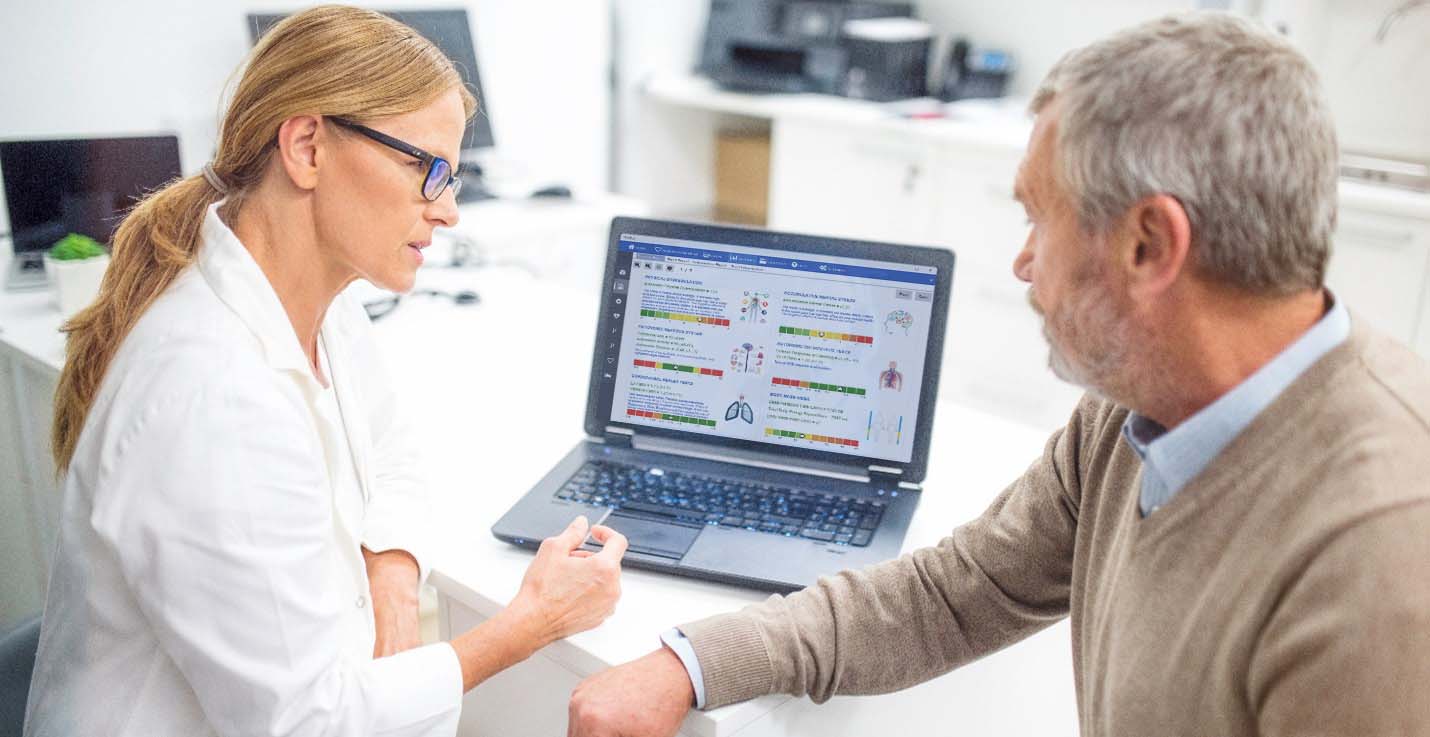- +1 800 433 4609
- |
- Request Info
Autonomic Function Assessments
Benefits all Medical Branches Including:
Primary Care, Cardiology, Pulmonology, Endocrinology, Neurology, Pain Management
VitalScan ANS Tilt
Autonomic Nervous System (ANS) Testing provides comprehensive, fully automated autonomic testing valuable equipment for physicians to gauge their patient's health and uncover hidden diseases. The system is US FDA 510(k) cleared.
Testing the autonomic nervous system can identify the following clinical autonomic disorders:
|
|
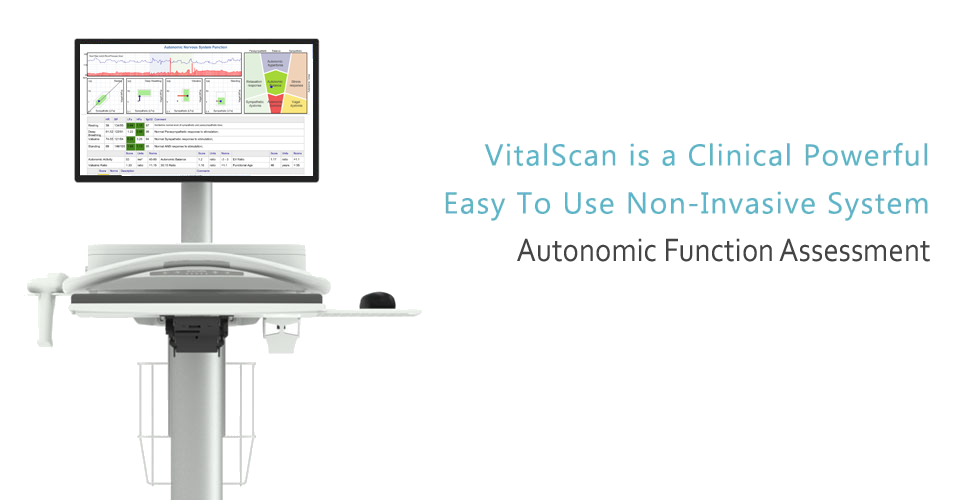
VitalScan ANS enables standardization and quantification!
In autonomic testing, standardized procedures are essential for reliable test results.
VitalScan ANS Tilt Test guides the operator and the patient through a series of autonomic test maneuvers.
Autonomic functional testing includes: Deep breathing, Valsalva and Tilt test with monitoring of heart rate, blood pressure (both continuous from finger and intermittent from arm), end tidal CO2, respiratory frequency, cerebral blood flow velocity, sympathetic and parasympathetic activity, and has the ability to record a video.
The VitalScan ANS Tilt Test provides instructions for the patient during the tests. Upon completion of the test, the application generates a PDF report with quantified results of all performed tests. Together, all these features support standardization and quantification of your autonomic tests!
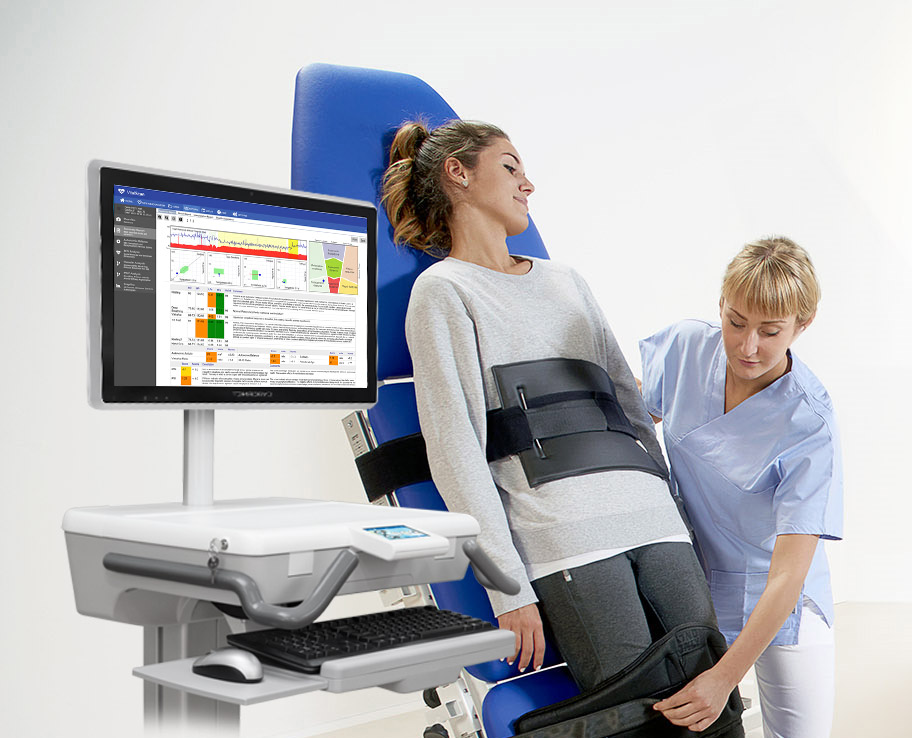
Autonomic Dysfunction (Dysautonomia)
The Autonomic Nervous System (ANS) is responsible for regulating involuntary bodily functions, such as heart rate, blood pressure, digestion, sweating, and more. These functions are controlled unconsciously. When the ANS doesn't function as it should, this is called Dysautonomia, Autonomic Dysfunction or Autonomic Neuropathy.
Dysautonomia refers to a group of medical conditions that result in malfunction of the autonomic nervous system (ANS).
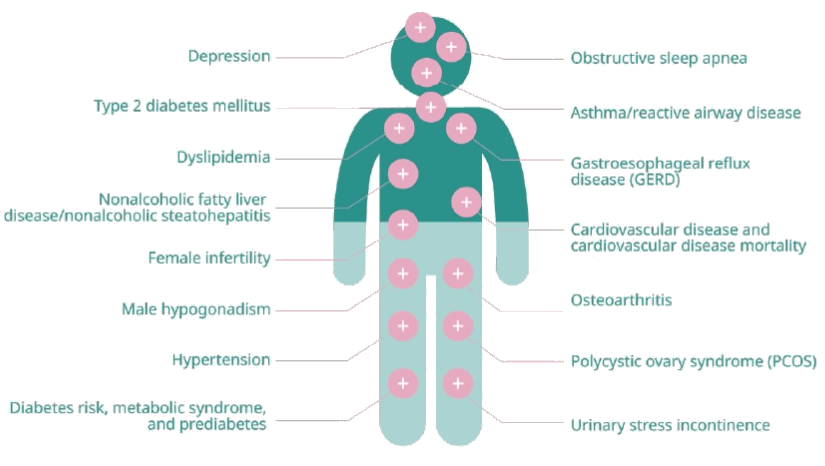
There are several types of dysautonomia, with varying symptoms and causes, but they all involve the ANS not working as it should. Some of the more common forms include:
The exact cause of many forms of dysautonomia is unknown, and diagnosis can sometimes be challenging because the symptoms can mimic many other conditions.
Common symptoms across different types of dysautonomia can include fatigue, dizziness, or lightheadedness, rapid or slow heartbeat, fluctuations in blood pressure, difficulty regulating body temperature, and problems with digestion.
- Postural Orthostatic Tachycardia Syndrome (POTS): is a cardiovascular autonomic disorder characterized by an increased heart rate and orthostatic intolerance when moving from lying down to a standing up position. Symptoms can include dizziness, fainting, rapid heartbeat, and fatigue.
- Neurocardiogenic Syncope (NCS): This is one of the most common types of dysautonomia and involves fainting or lightheadedness due to a temporary drop in blood pressure.
- Multiple System Atrophy (MSA): This is a rare and progressive neurodegenerative disorder. Symptoms can be similar to Parkinson's disease but with more pronounced autonomic dysfunction.
- Pure Autonomic Failure (PAF): As the name suggests, this is a disease characterized by the failure of all or most autonomic functions.
The exact cause of many forms of dysautonomia is unknown, and diagnosis can sometimes be challenging because the symptoms can mimic many other conditions.
Common symptoms across different types of dysautonomia can include fatigue, dizziness, or lightheadedness, rapid or slow heartbeat, fluctuations in blood pressure, difficulty regulating body temperature, and problems with digestion.
The VitalScan ANS includes:
|
|
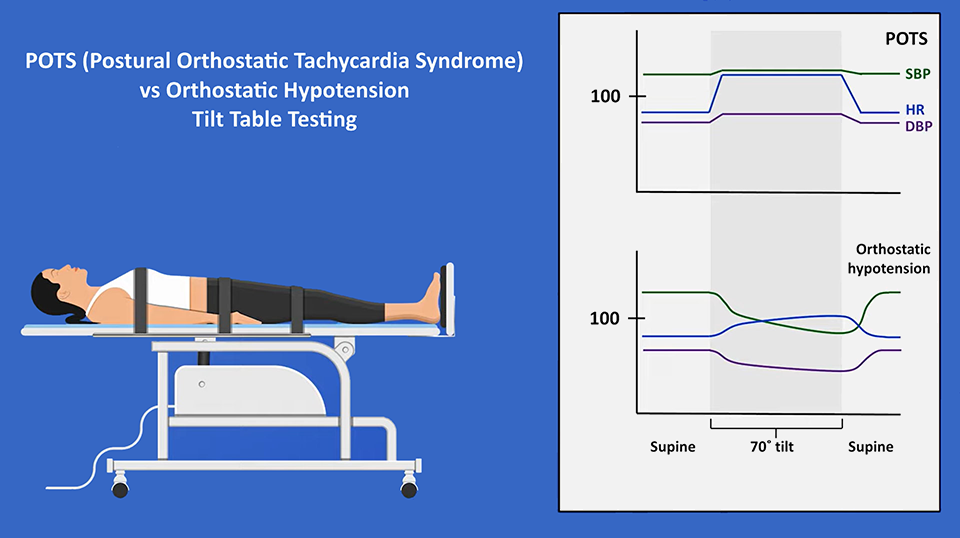
Valsalva Maneuver
Valsalva Maneuver tests the body's ability to compensate for changes in the amount of blood that returns to the heart. The Valsalva Maneuver requires the patient to blow into a tube to maintain for 15 seconds while your heart rate, EtCO2 and blood pressure, are being recorded. This may show abnormal baroreflex results in those with moderate to severe POTS. There is conflicting evidence on the accuracy of this particular test.
Deep Breathing
The Deep Breathing test evaluates the function of the vagus nerve that controls the heart. The purpose of this test is to examine how much the heart rate and parasympathetic activity changes in response to breathing in and breathing out. The test involves, following commands to breathe slowly and deeply for one/two minutes, while expansion of the chest, beat-to-beat blood pressure, heart rate, and SpO2, are recorded.

Hand Grip Test
This is exactly what it sounds like - you squeeze a hand grip dynamometer. First, they measure your maximum grip strength. Then you squeeze to maintain a percentage of your maximum, often 30%, for a set period of time or until your arm is fatigued. Those with autonomic dysfunction may show an increase in their diastolic blood pressure as the sympathetic nervous system is activated during the hand grip test.
Tilt Table Test
A Tilt table test is performed to determine whether standing up provokes a drop in blood pressure or fainting. The purpose is to reproduce a person's symptoms in a controlled setting.
After lying on a table for the first part of the test, the patient will be raised to a nearly upright position. The test will measure your blood pressure and pulse from laying to upright.
The Heart Rate coupled with blood pressure is measured, during the orthostatic changes in comparison to the resting baseline. This phase is done to see if being upright provokes a sudden fall in blood pressure, or hypotension, an excessive increase in pulse rate in POTS, patients, or fainting or syncope.
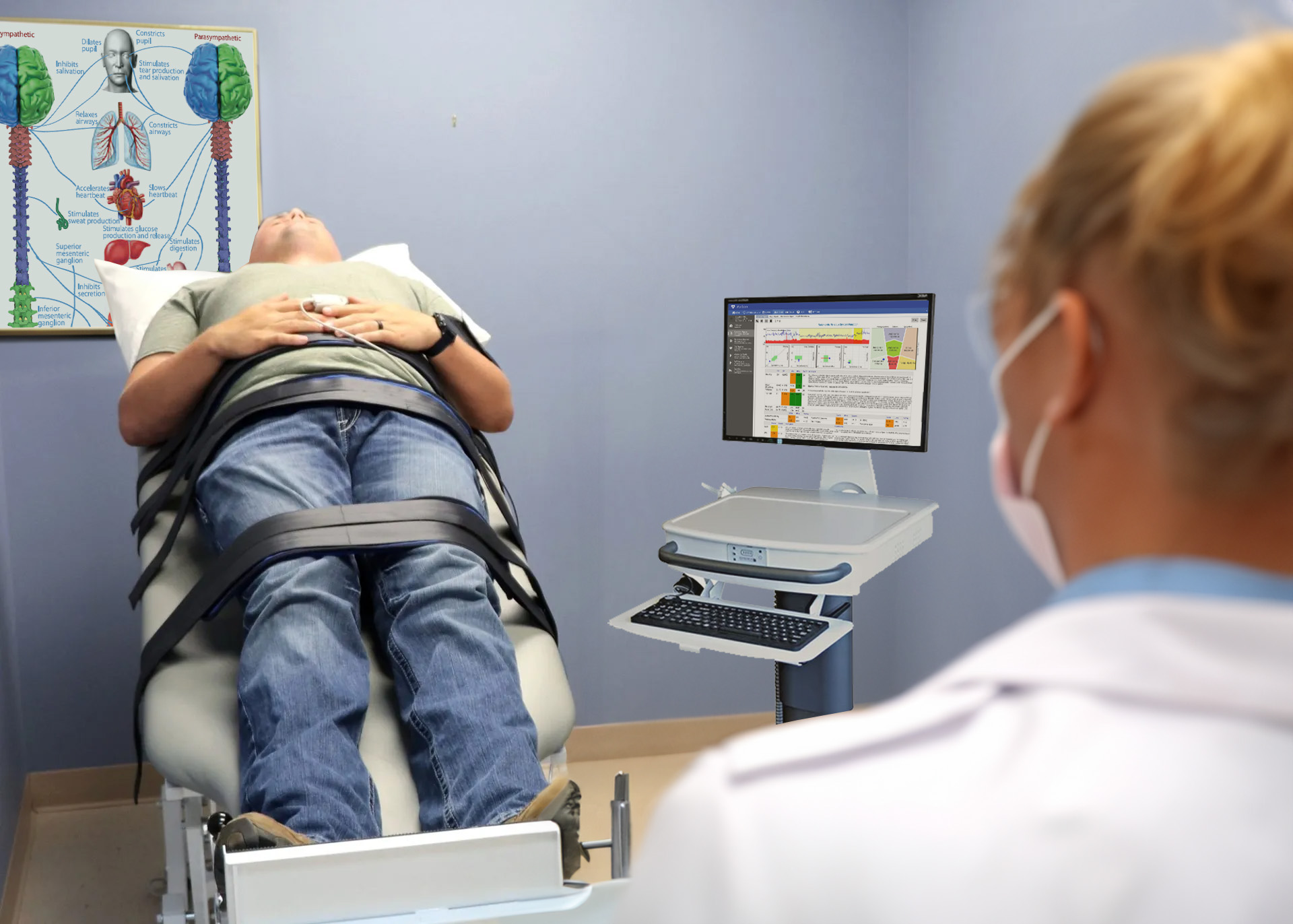
Video recording during Tilt Table test
A camera records a video of the patients' face during the Tilt Table test. Video recording is recommended by international autonomic testing guidelines, such as the ESC 2018 Guidelines for the diagnosis and management of syncope. They state: "Adding video recording to a tilt table test permits objective and repeated review of clinical signs in relation to Blood Pressure and Heart Rate, and helps to assess the relative contribution of bradycardia and hypotension to syncope".
Significant Clinical Applications
VitalScan ANS Tilt is a diagnostic tool to evaluate symptoms of vasomotor instability for any of the following:
- Diagnose the presence of autonomic neuropathy in a patient with symptoms suggesting a progressive autonomic neuropathy, including Diabetic neuropathy, Amyloid neuropathy, Sjogren's syndrome, Idiopathic neuropathy, Pure autonomic failure, and Multiple system dystrophy.
- Evaluate the severity and distribution of a diagnosed progressive autonomic neuropathy
- Differentiate the diagnosis between certain variants of syncope from other causes of loss of consciousness
- Evaluate inadequate response to beta blockade in vasodepressor syncope
- Differentiate the cause of postural tachycardia syndrome
- Evaluate change in type, distribution or severity of autonomic deficits in patients with autonomic failure
- Evaluate the response to treatment in patients with autonomic failure
- Diagnose axonal neuropathy or suspected autonomic neuropathy in the symptomatic patient
- Evaluate and diagnose sympathetically maintained pain, as in reflex sympathetic dystrophy or causalgia
- Evaluate and treat patients with recurrent unexplained syncope to demonstrate autonomic failure
VitalScan ANS Tilt assessments provide supplemental monitoring and optimized detection of cardiovascular, neurological, and metabolic conditions associated with many adverse health events. The VitalScan ANS Tilt product range offers physicians and health professionals convenient, cost-effective solutions for clinical testing and optimized patient assessment.
Applications include the following:
Applications include the following:
|
|
The VitalScan ANS Tilt system is a Class II medical device that is US FDA 510(k) cleared.
VitalScan ANS Tilt testing procedure is covered by the most major insurance providers, under CPT code 95921, 95922 or 95924.
VitalScan ANS Tilt testing procedure is covered by the most major insurance providers, under CPT code 95921, 95922 or 95924.

